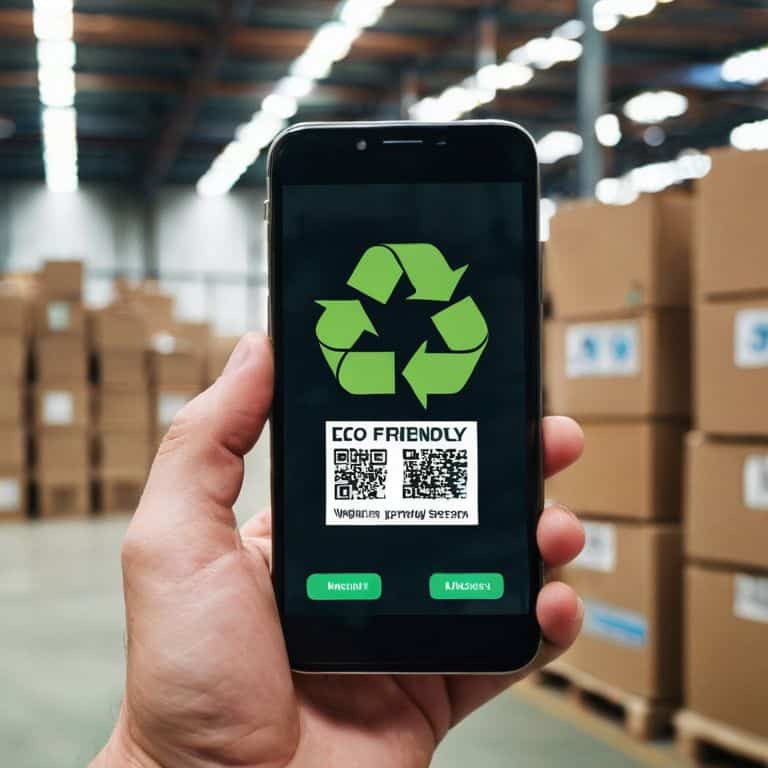I still remember the day I realized that my job as a smart home device designer was actually contributing to the problem of greenwashing in tech. We were touting our latest gadget as “eco-friendly” without any real evidence to back it up. It was a wake-up call for me, and I started to question the entire industry’s approach to sustainability. Now, I’m on a mission to help others learn how to spot greenwashing in tech, and it starts with being aware of the subtle ways companies can manipulate us into thinking their products are more environmentally friendly than they actually are.
As someone who’s been on the inside, I can tell you that it’s not always easy to separate fact from fiction. But in this article, I’ll share my expertise and provide you with practical tips on how to spot greenwashing in tech. You’ll learn how to read between the lines, identify red flags, and make informed decisions about the products you bring into your home. My goal is to empower you with the knowledge to see through the hype and make choices that truly align with your values. By the end of this guide, you’ll be equipped with the skills to navigate the complex world of tech and make a positive impact on the environment.
Table of Contents
- Guide Overview: What You'll Need
- Step-by-Step Instructions
- Cutting Through the Eco Hype
- Decoding Green Labels and Eco Friendly Claims
- Uncovering Hidden E Waste in Techs Sustainability Reports
- Beyond the Buzzwords: 5 Tips to Expose Greenwashing in Tech
- Key Takeaways to Avoid Greenwashing in Tech
- Beyond the Greenwash: A Call to Action
- Frequently Asked Questions
Guide Overview: What You'll Need

Total Time: 1 hour 15 minutes
Estimated Cost: $0 – $0
Difficulty Level: Intermediate
Tools Required
- Internet Connection (for research)
- Critical Thinking (to analyze information)
- Note-taking Device (e.g., pen and paper or a laptop)
Supplies & Materials
- List of Tech Companies (to research and evaluate)
- Greenwashing Red Flags Checklist (e.g., vague language, lack of transparency, exaggerated claims)
Step-by-Step Instructions
- 1. First, do your research on the company and its claims. Look beyond the marketing materials and press releases. Check out independent reviews, news articles, and social media to get a well-rounded view of the company’s environmental track record. This will help you understand the context behind their eco-friendly claims and identify any potential red flags.
- 2. Next, dig into the details of the company’s environmental impact statements. Look for specific data and metrics that support their claims, such as energy consumption, water usage, or waste reduction. Be wary of vague statements or buzzwords like “sustainable” or “eco-friendly” without any concrete evidence to back them up.
- 3. Check if the company is transparent about their supply chain. A truly eco-friendly company should be willing to disclose information about their suppliers, manufacturing processes, and material sourcing. If this information is difficult to find or seems overly secretive, it may indicate a lack of accountability.
- 4. Look for third-party certifications that verify the company’s environmental claims. Organizations like the Environmental Protection Agency (EPA) or the International Organization for Standardization (ISO) offer certifications for companies that meet certain environmental standards. Be sure to research the certification process and ensure it’s not just a rubber stamp.
- 5. Evaluate the company’s end-of-life policies for their products. A company that’s truly committed to sustainability should have a plan in place for recycling, refurbishing, or responsibly disposing of their products at the end of their life cycle. If this information is not readily available, it may indicate a lack of consideration for the environmental impact of their products.
- 6. Be cautious of greenwashing tactics like “carbon offsetting” or “planting trees” to compensate for environmental damage. While these efforts may be well-intentioned, they can be used to distract from the company’s overall environmental record. Look for concrete actions that address the root causes of environmental issues rather than just treating the symptoms.
- 7. Finally, use your own critical thinking to evaluate the company’s claims. Ask yourself questions like: Does the company’s environmental mission align with their business model? Are they using environmentally friendly materials and practices throughout their operations? Do they provide clear and consistent information about their environmental impact? By applying a critical eye to these questions, you can make a more informed decision about whether a company is genuinely committed to sustainability or just engaging in greenwashing.
Cutting Through the Eco Hype

As I delve deeper into the world of tech and sustainability, I’ve come to realize that identifying misleading sustainability labels is a crucial step in making informed decisions. It’s not just about looking for a certification or a label; it’s about understanding the context behind it. I’ve seen companies tout their products as eco-friendly simply because they’re made from recycled materials, without considering the environmental impact of the production process itself.
When evaluating tech companies’ claims, it’s essential to decode their corporate social responsibility reports. These reports often contain valuable information about the company’s environmental footprint, but they can be dense and difficult to navigate. I’ve found that looking for concrete data on carbon emissions, energy consumption, and e-waste generation can be a great way to separate fact from fiction. By doing so, we can get a better sense of a company’s true commitment to sustainability.
To take it a step further, I recommend evaluating tech companies’ carbon footprint by looking at their supply chain and manufacturing processes. This can be a complex task, but it’s essential for uncovering hidden e-waste generation and understanding the true environmental cost of our gadgets. By being more mindful of these factors, we can make more informed choices and promote a more sustainable tech industry.
Decoding Green Labels and Eco Friendly Claims
When I see a gadget stamped with an eco-label, my mind starts racing with questions. What does “eco-friendly” really mean in this context? Is it just a marketing ploy or a genuine effort to reduce waste? To decode these claims, I look for transparency. Are the materials used recyclable? Is the production process energy-efficient? I also search for third-party certifications, like Energy Star or EPEAT, which offer a more objective measure of a product’s environmental impact. It’s not just about slapping a green label on a device; it’s about providing concrete evidence of its eco-friendliness.
I’ve found that some companies are now using terms like “carbon neutral” or “sustainably sourced” without providing any real data to back it up. That’s where my curiosity kicks in – I start digging into the fine print, looking for specifics on how they’ve achieved these claims. By doing so, I hope to inspire a similar sense of curiosity in my readers, encouraging them to think critically about the tech they bring into their lives.
Uncovering Hidden E Waste in Techs Sustainability Reports
When dissecting tech companies’ sustainability reports, it’s crucial to look beyond the sleek graphics and triumphant language. I’ve found that a closer examination often reveals a more nuanced story. For instance, a company might boast about reducing packaging waste, but neglect to mention the increased e-waste generated by their devices’ shorter lifespans. It’s essential to scrutinize the data, searching for inconsistencies and omissions that might indicate a more significant environmental footprint than claimed.
By doing so, we can uncover the hidden e-waste that’s often glossed over in these reports. I’ve seen cases where companies proudly declare their commitment to recycling, yet fail to provide concrete numbers or explain the actual recycling process. As someone who’s passionate about repurposing old tech, I believe it’s our responsibility to hold these companies accountable and demand transparency in their sustainability claims.
Beyond the Buzzwords: 5 Tips to Expose Greenwashing in Tech
- Look for Specific Data: If a company claims their new gadget is eco-friendly, check for concrete numbers and metrics to back it up – vague promises won’t cut it
- Check for Third-Party Certifications: Reputable certifications like Energy Star or EPEAT can give you a better sense of a product’s actual environmental impact
- Don’t Fall for Green Packaging: Just because the box is made from recycled materials doesn’t mean the product itself is sustainable – dig deeper into the device’s lifecycle
- Follow the Supply Chain: A company might tout their own eco-friendly practices, but what about their suppliers? Look for transparency about their sourcing and manufacturing processes
- Watch for Overemphasis on Recycling: While recycling is important, it’s often used as a distraction from more significant environmental issues – consider the entire product lifecycle, from design to disposal
Key Takeaways to Avoid Greenwashing in Tech
Verify eco-friendly claims by looking beyond the label and researching the company’s actual environmental impact and sustainability reports
Be cautious of vague terms like ‘biodegradable’ or ‘energy-efficient’ without specific data to back them up, and watch for greenwashed marketing that prioritizes image over substance
Demand transparency from tech companies by supporting those that provide clear, detailed information about their production processes, e-waste management, and end-of-life product recycling, and use your voice to call out greenwashing when you see it
Beyond the Greenwash: A Call to Action

As we’ve navigated the complex world of tech and sustainability, it’s become clear that spotting greenwashing requires a mix of skepticism and awareness. From decoding green labels to uncovering hidden e-waste, we’ve covered the essential steps to make informed decisions. By understanding how companies can manipulate eco-friendly claims and recognizing the importance of transparency in sustainability reports, we can begin to see through the facade and demand more from the tech industry.
So, what’s the next step? It’s time to reclaim our relationship with technology and push for a future where gadgets serve humanity, not the other way around. By supporting companies that prioritize genuine sustainability and holding others accountable for their actions, we can create a ripple effect that inspires real change. The journey to a more sustainable tech future starts with each of us, and together, we can make a difference, one device at a time.
Frequently Asked Questions
What are some common tactics tech companies use to make their products appear more eco-friendly than they actually are?
One tactic is “component cherry-picking,” where companies highlight eco-friendly parts while downplaying the overall environmental impact. Another is “recycling misdirection,” emphasizing recyclable materials without revealing the actual recycling rates or processes. Then there’s “sustainability report spin,” showcasing vague, feel-good metrics that obscure real e-waste issues.
How can I verify the authenticity of a tech company's sustainability claims and distinguish them from clever marketing?
To verify a tech company’s sustainability claims, I always look for third-party certifications and transparent data. Check if they’re using standardized labels like Energy Star or EPEAT, and dig into their sustainability reports for specific numbers, not just vague promises.
Are there any specific certifications or labels that I should look for when trying to identify genuinely eco-friendly tech products?
Look for third-party certifications like Energy Star or EPEAT, which set strict standards for energy efficiency and environmental impact. Also, check for labels like “carbon neutral” or “conflict-free,” but be wary of vague terms like “eco-friendly” or “sustainable” – they’re often just marketing buzzwords.
